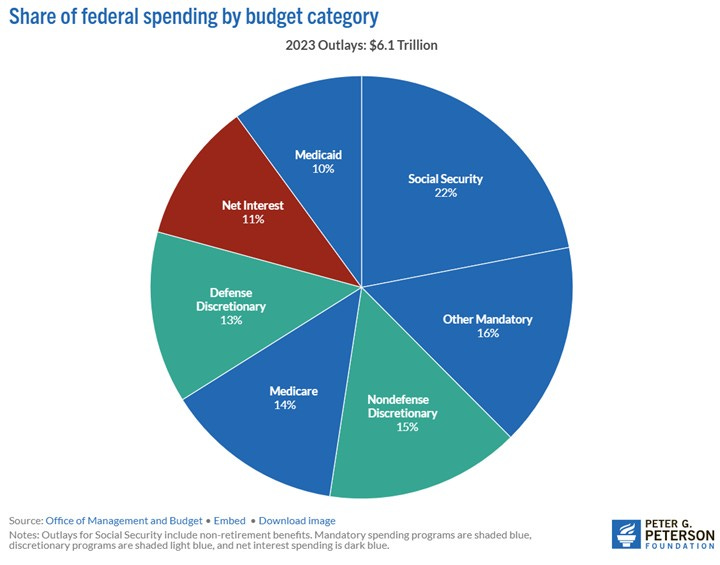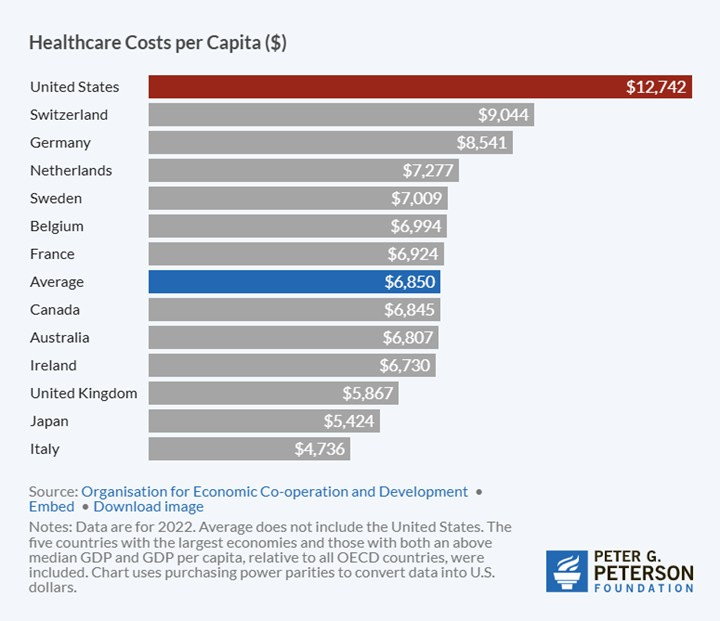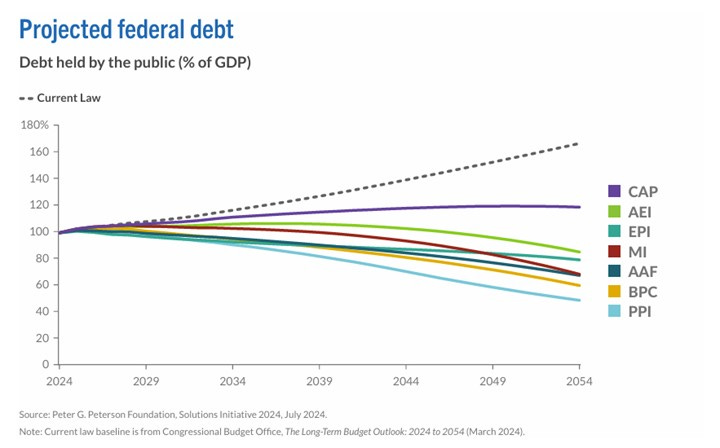Preface
One sees and hears almost constantly in the media these days about the severity and urgency of our ever-growing federal debt. See the June 17 post on Severity.
The word Plan in this article’s title is defined as a detailed blueprint produced by a Congressional Commission to be enacted by Congress and meet the objective below.
The Plan is a complete legislative document draft, and its objective includes “…a balanced and fair plan that will put our country on a responsible fiscal path forward…in ways that will endure future temptations to weaken or destroy it.” The task is to correct the errors, excesses, and failures not to have acted sooner – resulting in a future that is fiscally responsible in a nonpartisan manner indefinitely.
The Substack post WHO… on July 2 made clear that Congress must be the entity that solves the federal debt predicament. It also presented the dichotomy between Congress’s responsibility and its weak track record in recent years in solving big problems. Hence the reason for this article. The necessary Plan is too complex, huge, technical, and political for its creation to take place on the floors of Congress.
So, since time is of the essence, HOW should and can Congress produce and enact the Plan?
Keys to Success in the Plan’s Development
Expertise – Creating the Plan will require the best and most experienced experts in many fields including: time value of money, bond markets, Social Security and pension plans, Medicare and other medical programs, tax law and policy, effect of interest costs and other federal programs on federal budgets, budgeting, effect of the economy on a prudent debt level, computer modeling of many possible paths forward, project management, impact of various changes on all levels of families and businesses, historical effects of debt emergencies in our country and others, ability to communicate to the public the needs for changes in order to ward off much worse events later, the techniques that countries have used successfully in avoiding excessive debt, and much more.
Concentration – This project deserves and requires a team composed of experts who can and will devote themselves to it full time – or something quite close to that.
Speed – Every month that passes prior to measures being implemented bringing the deficit and debt malady under control increases the costs of doing it later. Also, projects that are crisply executed and well managed almost always produce more satisfactory results.
Balance – There are many moving parts to the U.S. economy and to the fiscal affairs of the federal government. Some of them must be altered to bring the federal deficits and debt under control. There are variations in how important they are to various income levels, age levels, health, incentives, happiness, and the relative importance of the many federal programs, so careful thought must be exercised in making changes. Members of the Congressional Commission must balance possible changes in policy and law with others and with meeting the objectives of the Plan to make the most efficient and acceptable decisions.
Acceptability – The Plan must be acceptable to members of Congress so it can be executed into law; otherwise, it can’t do its work. It also must be understood and accepted by the public, partially because they will be personally involved, and because they influence the acceptance Congress will have of the Plan.
Minimal Political Influence – Remember that the objective includes the words “a balanced and fair plan that will put our country on a responsible fiscal path forward”. We have seen what effects political influence has had on federal tax and spending decisions, so the Plan must be designed to produce a responsible fiscal path forward - without much political influence.
Fulfills the Objective – Res ipsa loquitur. Of course, we want to remove permanently the rapidly growing risks of excessive federal debt.
Using a Congressional Commission to Develop the Fiscal Plan
What is a Congressional Commission? The Congressional Research Service, referenced below “…defines it as a multimember independent entity that (1) is established by Congress, (2) exists temporarily, (3) serves in an advisory or commemorative capacity, (4) is appointed in whole or in part by Members of Congress, and (5) reports to Congress.”
There are strong reasons for Congress to use a Congressional Commission for the Fiscal Plan. The report says: “By establishing a commission, Congress can potentially provide a highly visible forum for important issues and assemble greater expertise than may be readily available within the legislature. Commissions can allow for the examination of complex policy issues over a longer period and in greater depth than may be practical for legislators. The nonpartisan or bipartisan character of most congressional commissions may also make their findings and recommendations more politically acceptable, both in Congress and to the public.” This description of the advantages of a Congressional Commission fits the requirements of the Enduring Federal Fiscal Plan like a glove.
The Congressional Research Service’s paper Congressional Commissions: Overview and Considerations for Congress is available at this link: www.congress.gov/crs-product/R40076 . It has 22 pages, is very informative, and includes links to copies of the Commission’s reports for many years. They are used fairly infrequently and can be quite effective when they are needed. There need be no mystery about these Commissions.
What Should be Included in Congress’s Charge Creating the Commission
The objective, and a due date for submission of the Plan to Congress
Requirement for a high priority and tight schedule of votes in the House and Senate to enact the Plan with little or no opportunity for amendments and possibly a requirement for a super-majority vote – to be part of the submitted Plan.
Requirement for the Commission to conduct program(s) specifically designed to educate the public about the risks of our Relentless Federal Debt Growth, how the Commission is approaching the challenge and why, and the reasons why facing the predicament squarely is much better than continuing to ignore it.
Requirement for language setting fiscal measure limit or limits that automatically trigger mandatory immediate and effective corrective measures including penalties on members of Congress themselves for non-compliance.
Requirement for Congress to act within a month of passage of the bill to call for an amendment to the Constitution that does essentially the same as the paragraph above.
Requirement for a summary version of the Plan for the public
Language of an administrative nature giving the Commission the compensation, staff, offices, expenses, access to congressional committees and appropriate government agencies, ability to call witnesses, and any other tools needed to satisfy the objective well and as quickly as practicable.
Any other language the charge should ensure the Commission has the resources and power to do its task well.
Membership of the Commission
Analyzing the dangerous and urgent predicament and merging all the complex and interrelated ways to improve it requires expertise that is found in people and organizations that have devoted themselves to this challenge in recent years. More of this under the next heading.
Members of Congress, even if they have strong concerns about our fiscal situation, all have many other responsibilities and duties that are constantly demanding their attention: floor votes, committee activities, campaigning, managing a staff, interacting with constituents on a huge variety of unrelated issues, traveling, spending time in their districts, and much more. Perhaps more important, they have tremendous pressures from their parties to lean heavily with one political wind or the other. Having members of Congress on the Commission, especially in a voting capacity, would risk bringing political biases into the task of creating a balanced and bipartisan Plan. It could intimidate the outside experts, causing them to be non-objective, subservient, or even to lose interest in remaining on the Commission. All members of Congress will have the opportunity to vote on the final Plan as a legislative bill. The Congressional Commission will be able to work as closely with Congress as appropriate and to request and promptly obtain testimony, reports, and data from Congress upon request.
Therefore, it would be wise to populate the Congressional Commission completely or almost so with experts from outside Congress. Below are sensible guidelines for the membership:
Non-voting: none, or a maximum of four members of Congress.
Voting: experts from outside Congress, enough to have the necessary expertise without having so many that the group size is unwieldy. Perhaps the charge should leave some flexibility for the Commission itself to adjust the number of voting members as needed. These experts should make this Plan project be their main activity for its duration.
from the Peter G. Peterson Foundation
The chart above is shown to reinforce that the Commission must be intimately familiar with each category of spending - financially, technically, and its impact on the federal government as well as on the individuals who deeply are involved both as the ultimate source of money and as receivers of most of the services. AND this is just the spending portion of the puzzle; the income challenges are similarly complex as well as the borrowing.
from the Peter G. Peterson Foundation
Similarly, the chart above also shows the need for making non-partisan decisions that are fair and balanced, but challenging, in striving to create “…a balanced and fair plan that will put our country on a responsible fiscal path forward”.
Expertise and Research are Already Available
from the Peter G. Peterson Foundation
The chart above is just a small sample evidencing the plethora of active research and the amount of useful data available in think tanks and academia on the federal debt issue. It resulted from a 2024 conference held by the Peter Peterson Foundation and summarized the computer-modeled projections of the participants who are shown below. Not only is it obvious how much information is available on the federal debt issue, but it shows that the people in these institutions already work well together!
Center for American Progress
American Enterprise Institute
Economic Policy Institute
Manhattan Institute
American Action Forum
Bipartisan Policy Center
Progressive Policy Center
Other institutions in this field include:
Committee for a Responsible Budget
Congressional Budget Office
The Concord Coalition
Center on Budget and Policy Priorities
National Priorities Project
Brookings Institute
Hoover Institution at Stanford
Penn Wharton Budget Model
The Budget Lab at Yale
I have a thoroughly marked-up printed copy of the 40-page budget plan referenced below, having studied it carefully three times over the past several months. I was impressed at the care taken to arrive at changes that produce a responsible fiscal path for the next 30 years while being cautious to avoid spending or tax changes that would be unfair or excessively painful. It may or may not be the best effort available, and it may or may not be better than what a Congressional Commission could create. BUT it is available now, and it is light years better than the existing laws on the books that are producing deficits of around $2 trillion per year and forecast to grow over the next 10 years and get worse after that time. So, the point of this section of this paper is that it certainly appears that the expertise, research, existing computer models, and proposed solutions may be adequate for a qualified commission to create a good fiscal Plan in an amazingly short time.
Summary
The deficit (i.e. additional federal borrowings for one year) is estimated for FY 2025 to be $5,500 per person in the USA. The interest payment on all the accumulated federal debt will be in 2025 well over $2,000 per person. These numbers are per person, not per family!
It is estimated that for FY 2025, Federal outlays including interest will be $6,825 billion; this amount is being paid $4,918 billion from revenues with the remainder coming from borrowing (the deficit), namely $1,907 billion or 28% of the outlays. We are borrowing 28% of what we spend in the federal government! Does your family do that? It is time for change. So, once more per Albert Einstein, “Insanity is doing the same thing over and over again and expecting a different result.”
Advantages
A Congressional Commission can hit the ground up-to-speed.
Appointing people already devoted to this problem virtually ensures competence and focus.
This process will produce a good Plan – soon.
A Commission can perform the work on a tight schedule and in a fair and acceptable way - to both the public and members of Congress.
Overall, it will solve our federal fiscal debt problem responsibly before serious harm occurs.
Ray Dalio says in his new book How Countries Go Broke: “Now is an exceptionally good time to implement a significant debt limit plan…”. He is an avid student of long-term fiscal and monetary cycles and risks.
One might ask: Is this Plan project going to cost a lot of money? No, not when compared with our 2025 estimated deficit of $1,907 billion in a year or $5,200 million per day. This fiscal problem shrieks to be solved properly and soon!
Every member of Congress should be able to look at this approach to this huge problem and say: I like it because: 1) It has become obvious that Congress is going to be forced to address the dangerous federal debt matter soon, 2) The predicament clearly requires lots of expertise, 3) I don’t want to get into a party fight in which I will be on the wrong side of many delicate issues, 4) Every other member of Congress feels as I do, 5) So, it makes good sense for me to participate in an approach to this predicament that will solve it fairly and leave me with honor rather than political baggage.
This can happen: Congress acts to establish the Commission – with no real risk to its members. The Commission’s Report, the Plan, is sound and well publicized. The public and members of Congress understand by then that we don’t have a choice. No one person or party is viewed as promoting change contrary to the wishes of others. The Congressional Commission Plan passes Congress and is signed into law, placing the U.S. government on the pathway to fiscal prudence. Also, we will have significantly reduced many sources of interparty friction in Congress.
References
Peter G. Petersen Foundation, PowerPoint Presentation
Congressional Research Service, www.congress.gov/crs-product/R40076
Committee for a Responsible Federal Budget, https://www.crfb.org/
Other institutions mentioned in this article’s section titled: Expertise and Research are Already Available
A Comprehensive Federal Budget Plan to Avert a Debt Crisis | Manhattan Institute
Jessica Riedl
Tom Mast Arlington Cemetery
The photo above is a reminder that there were Americans who gave everything for their country. Now is the time to realize that we need to yield a little (of the money we are borrowing from our grandchildren) to prevent a debt crisis.





